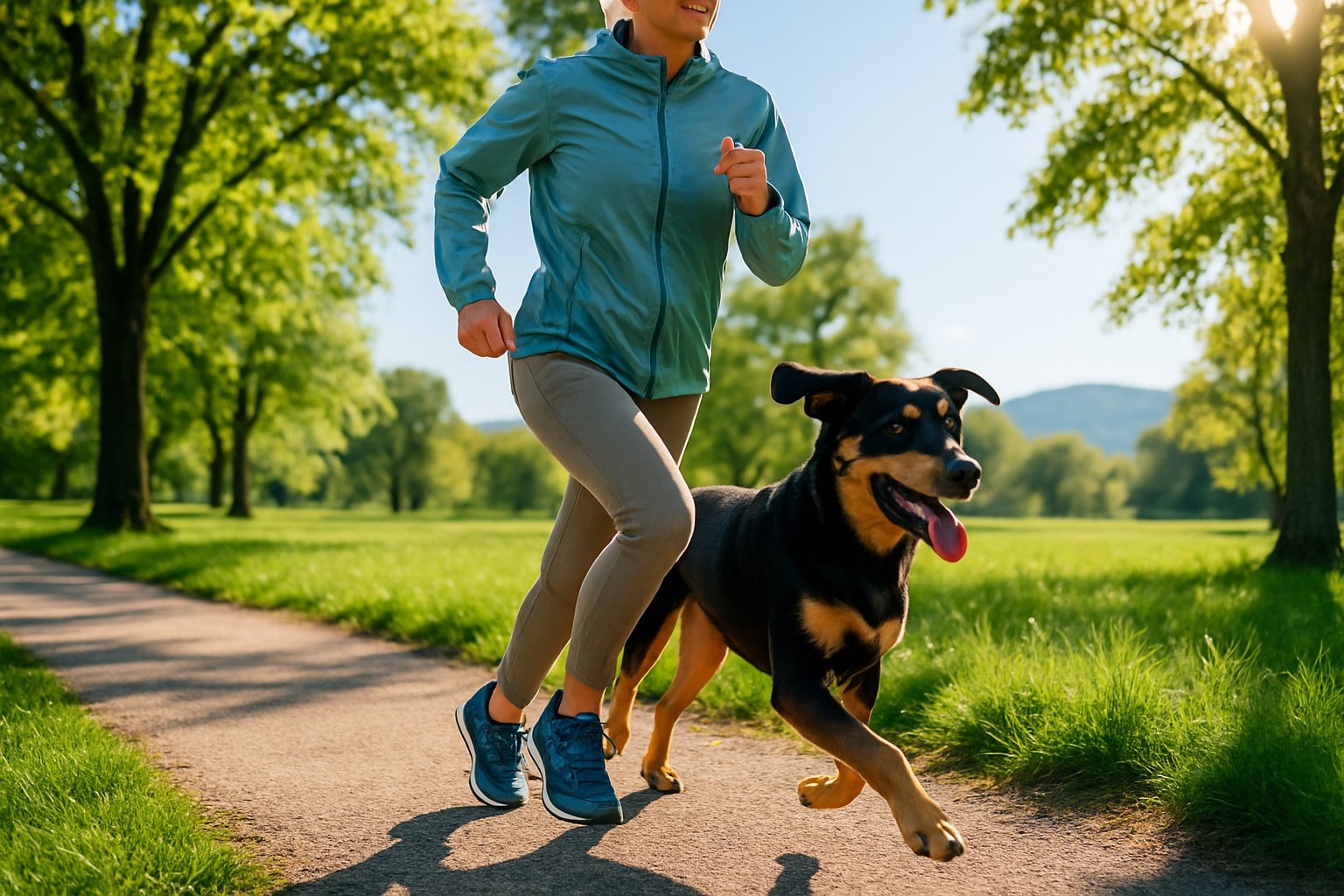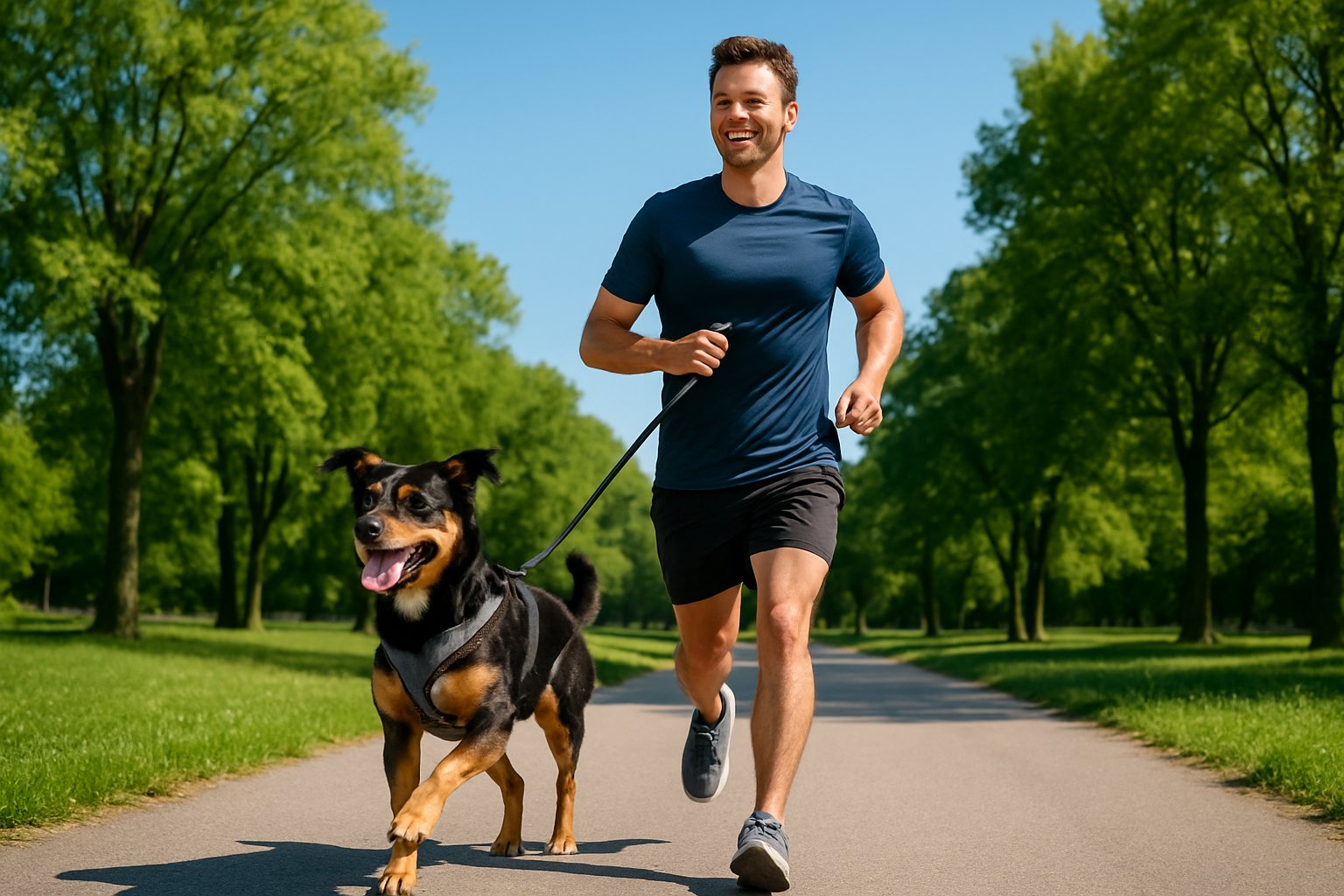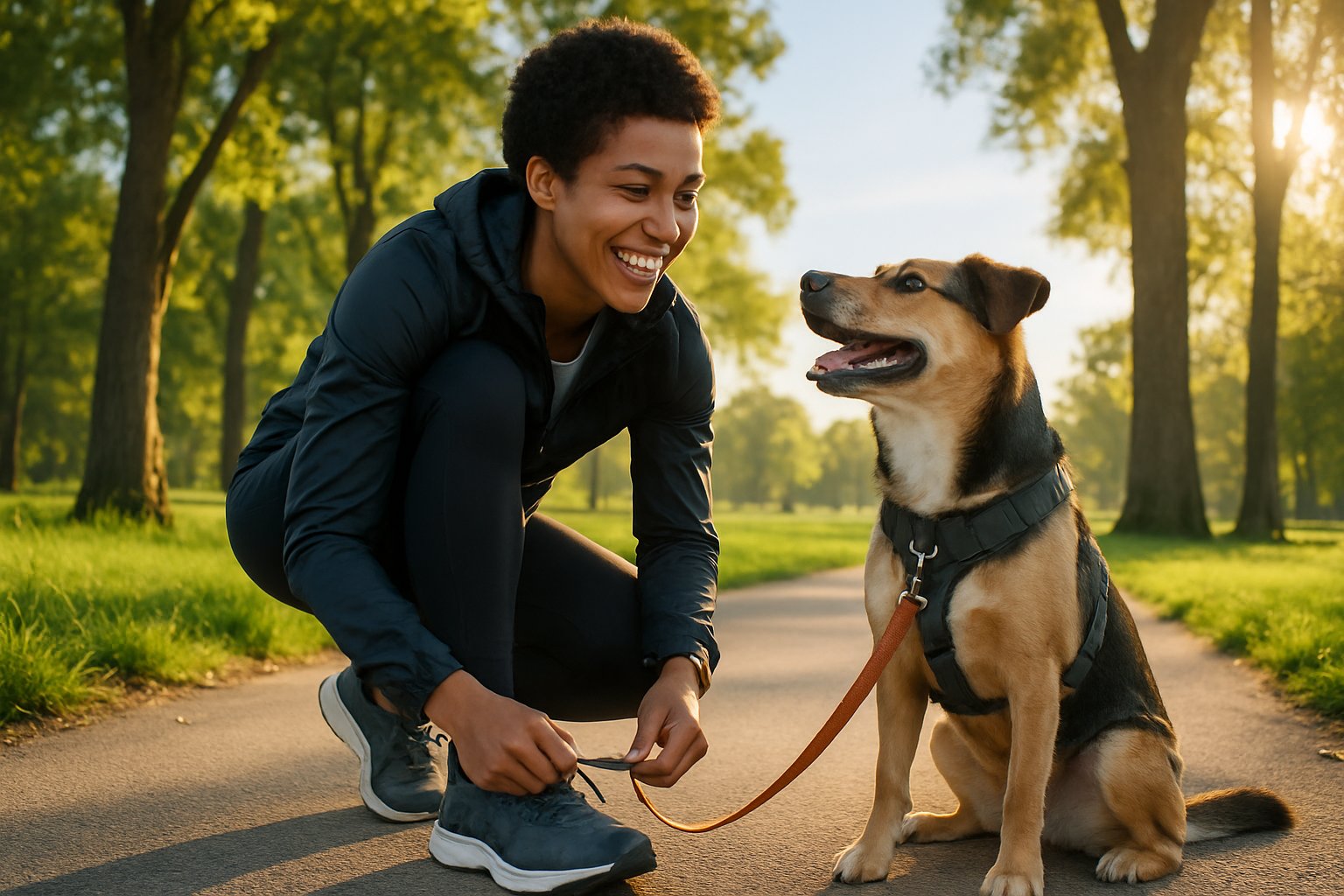Running with your dog can turn an ordinary workout into a shared adventure. You both get fit, spend quality time together, and strengthen your bond in the process.
Running with your dog helps improve your fitness while keeping your dog happier, calmer, and healthier. It’s a simple way to make exercise more enjoyable and meaningful for both of you.

Before you grab the lead, though, think about your dog’s age, breed, and health. Some dogs thrive on long runs, while others do better with brisk walks or short jogs.
With the right preparation, gear, and a bit of training, you can make every run safe and rewarding for you both.
Whether you’re starting slow or planning to hit the trails, learning how to pace together and stay safe will make all the difference. From choosing the right harness to building endurance, this guide will help you and your dog run side by side with confidence.
Key Takeaways
- Learn how to decide if running suits both you and your dog
- Discover simple steps to prepare for safe, enjoyable runs
- Find out how the right habits and gear make running together easier
Is Running with Your Dog Right for You Both?
Running with your dog can strengthen your bond, boost fitness, and bring joy to your daily routine. Before you start, think about your dog’s health, breed, and personality to make sure running is safe and enjoyable for both of you.
Assessing Your Dog’s Health and Fitness
Before you head out, check that your dog is healthy enough for running. A vet visit helps confirm that their joints, heart, and lungs can handle the activity.
Dogs with breathing issues or joint problems may need gentler exercise instead. Start slow and build up distance and pace over time to help your dog’s muscles and stamina grow safely.
Watch for signs like heavy panting, limping, or slowing down—these can mean your dog needs a break. Keep hydration in mind and bring a portable water bowl for water stops every 15–30 minutes, especially in warm weather.
If your dog struggles to keep up, switch to shorter jogs or brisk walks. You can find more advice on safe preparation for running with dogs from PetMD.
Understanding Breed Suitability
Different breeds have different running abilities. High-energy dogs like Border Collies, Vizslas, and Labrador Retrievers often make great companions for longer runs because they have strong endurance and love to stay active.
Short-nosed breeds such as Bulldogs or Pugs can overheat easily and may struggle to breathe during intense exercise. Large breeds like Great Danes may face joint strain from frequent running.
Here’s a quick comparison:
| Breed Type | Running Potential | Notes |
|---|---|---|
| Border Collie | Excellent | High stamina and focus |
| Vizsla | Excellent | Energetic and eager to run |
| Bull Terrier | Moderate | Strong but can tire quickly |
| Pug | Poor | Breathing issues limit endurance |
Choosing the right pace and distance for your dog’s breed helps keep them safe and happy. Learn more about breed suitability for running from Blue Cross.
Considering Age and Personality
Your dog’s age and temperament matter as much as their fitness level. Puppies’ joints are still developing, so it’s best to wait until they’re fully grown before starting a running routine.
Senior dogs may prefer slower, shorter runs or walks. Personality also plays a role.
Some dogs thrive on routine and love running beside you, while others get distracted or anxious in busy areas. If your dog pulls or lunges, try a no-pull harness to make runs safer and more enjoyable.
A calm, confident dog that enjoys being outdoors will adapt best to running. If your dog seems nervous or uninterested, try shorter sessions or different routes until they feel comfortable.
Preparing for Your First Run Together
Before you and your dog start running, make sure they’re healthy, comfortable, and ready for the activity. Planning ahead helps avoid injuries and keeps your dog safe.
Consulting Your Vet
Your vet can help you decide if your dog is fit for running. Dogs with joint issues, heart problems, or breathing difficulties may need a different kind of exercise.
Breeds with short muzzles, like Pugs or Bulldogs, often struggle with long runs due to breathing limits. Ask your vet about your dog’s ideal running distance, pace, and age readiness.
Puppies should avoid long runs until their joints fully develop. Older dogs may need shorter, slower sessions.
It’s also smart to check vaccinations and flea or tick protection before starting outdoor runs. According to PetMD’s guide to running with your dog, keeping up with preventive care helps protect your dog from common outdoor risks.
If your vet gives the all-clear, start slowly and build endurance over time. A gradual routine helps your dog stay healthy and confident.
Choosing the Ideal Route
Pick routes that suit both your fitness levels and your dog’s comfort. Soft surfaces like grass, dirt trails, or park paths are easier on paws and joints than concrete or asphalt.
Avoid busy roads or crowded areas where noise and traffic could stress your dog. Instead, look for quiet neighbourhood streets or dog-friendly parks.
The Running 101 guide to running with your dog recommends starting with familiar routes before exploring new ones. Bring essentials such as:
- Water and a collapsible bowl
- Poop bags
- Reflective gear for early mornings or evenings
If your dog tends to pull, a hands-free waist leash or no-pull harness can make the run smoother and safer for both of you.
Timing and Weather Considerations
Dogs can overheat faster than humans, so timing matters. Run during cooler hours—early morning or evening—to avoid heat stress.
Check the ground temperature before heading out. If the pavement feels too hot for your hand, it’s too hot for your dog’s paws.
Dog booties can help protect their feet on rough or hot surfaces, as suggested by PetMD’s safety tips. In cold weather, shorter runs or protective clothing may keep your dog comfortable.
Always monitor for signs of fatigue, heavy panting, or limping. Keep runs shorter at first, adjusting distance and pace as your dog builds stamina.
Essential Gear for Running with Your Dog
When you run with your dog, the right gear keeps both of you safe, comfortable, and in sync. Choosing suitable leads, harnesses, and hydration tools helps prevent strain and supports good control.
It also ensures your pup stays healthy and visible on every run.
Selecting the Right Lead and Harness
A hands-free lead lets you move naturally while keeping your dog close. Many runners prefer waist-attached options because they reduce pulling and free your arms.
Some models, like the ones featured by Runner’s World, include bungee sections that absorb shock and prevent sudden jerks. Choose a harness that fits snugly but doesn’t restrict movement.
Look for padded straps to avoid chafing and reflective trim for visibility in low light. The Blue Cross recommends harnesses over collars since they reduce neck strain, especially for energetic dogs.
If you run with more than one dog, a dual-lead belt can help keep them balanced on either side. Adjustable clips and storage pockets for treats or bags make these belts practical and comfortable.
Always check that clips and buckles are sturdy before heading out.
| Feature | Why It Matters | Example |
|---|---|---|
| Bungee lead | Reduces pulling | Waist-worn leads |
| Reflective harness | Improves visibility | Early morning runs |
| Padded straps | Prevents rubbing | Long-distance runs |
Hydration and Safety Accessories
Dogs need regular water breaks, especially on warm days. A portable water bottle with an attached bowl makes it easy to share water mid-run, as shown in Runner’s World’s gear guide.
Collapsible bowls are lightweight and fit neatly in a pocket or belt. Keep your dog visible with reflective or LED vests.
These are essential for early morning or evening runs, helping drivers and cyclists see your pet. Some vests even include rechargeable lights for extra safety.
Pack eco-friendly waste bags for clean-up and a small first-aid kit for minor cuts or scrapes. If you run in rough terrain, consider dog booties to protect paws from hot pavement or sharp stones.
Training Your Dog to Run Safely
Training your dog to run takes patience, structure, and consistency. You’ll need to build fitness slowly, teach reliable lead manners, and help your dog stay calm and focused around people, other dogs, and distractions.
These steps create safer, more enjoyable runs for both of you.
Building Up Endurance Gradually
Start with short runs and mix in walking breaks. Most dogs need time to build up their muscles and joints before they’re ready for longer distances.
Gradually add distance and increase pace over a few weeks. That way, you help your dog avoid strain or injury.
Puppies shouldn’t run far until their bones finish developing. Adult dogs also need a warm-up and cool-down to keep stiffness at bay.
Watch your dog’s breathing, gait, and energy. If your dog pants hard or starts lagging, take a break.
According to PetMD’s guide on running with your dog, some breeds—like Labradors or Vizslas—are natural endurance runners, but flat-faced breeds might struggle more with heat and airflow.
Try a simple routine:
| Week | Distance | Notes |
|---|---|---|
| 1–2 | 0.5–1 mile | Include walking intervals |
| 3–4 | 1–2 miles | Increase pace slightly |
| 5–6 | 2–3 miles | Maintain steady rhythm |
Loose-Lead Walking and Recall Skills
Before you run, your dog should walk calmly on a loose lead. Pulling or weaving could cause you both to trip or get hurt.
Practise short sessions and reward your dog for staying by your side. A hands-free waist leash can make things easier, as Blue Cross suggests.
Work on recall in quiet spots. Call your dog back, reward, and then let them go again.
This builds trust and responsiveness for off-lead runs in safe places. Stay consistent with cues and rewards.
Dogs really do learn best when training feels positive and predictable.
Managing Distractions and Socialisation
Running outside means new sights, smells, and sounds for your dog. Gradually introduce them to other runners, cyclists, and dogs.
Keep early sessions short and relaxed so your dog gains confidence. Reward calm behaviour when distractions pop up.
If your dog reacts or pulls, stop and get their attention back on you. This helps teach focus and lowers stress during busier runs.
The PDSA recommends making sure your dog’s harness fits well and doesn’t rub. That helps keep them comfortable and focused.
Best Dog Breeds for Running Companionship
Finding the right dog for your pace helps both of you stay happy and healthy. Some breeds thrive on long-distance runs, while others do better with shorter, slower outings because of their body type or breathing needs.
High-Energy Breeds for Long-Distance Runs
If you love endurance running, you’ll want a dog that keeps up. Breeds like the Weimaraner, German Shorthaired Pointer, and Rhodesian Ridgeback are made for distance.
They have lean bodies, strong muscles, and a drive to stay active. Dogs such as the Vizsla and Dalmatian also make great long-distance partners.
The Vizsla has impressive endurance and does well in warm weather. The Dalmatian’s athletic build helps it keep a steady pace on soft trails.
When you run with these breeds, choose routes with shade and water breaks. Even energetic dogs need care and downtime after long sessions.
Regular vet checks help keep them fit for training.
| Breed | Ideal Distance | Key Traits |
|---|---|---|
| Weimaraner | Long runs | Strong, loyal, energetic |
| Vizsla | Moderate to long | Agile, affectionate, heat-tolerant |
| Dalmatian | Long | Enduring, athletic, social |
Short-Nosed and Less Suitable Breeds
Some dogs just aren’t built for endurance running. Short-nosed (brachycephalic) breeds like Bulldogs, Pugs, and Boxers have trouble cooling off during exercise.
Their shorter airways make breathing harder, especially when it’s warm. These breeds can still enjoy walks or light jogs but should skip long or intense runs.
Overdoing it can lead to overheating or breathing trouble fast. If you have one of these dogs, stick to short, shaded routes and bring water for lots of breaks.
Always watch for signs of fatigue like heavy panting, slowing down, or drooling. Your dog’s comfort and safety matter most.
Spotlight on Collies, Vizslas, and Bull Terriers
Collies make dependable running buddies thanks to their intelligence and stamina. They love structured routines and respond well to training, making it easy to find a good pace together.
The Vizsla is sleek, affectionate, and loves sticking close during runs. This breed thrives on daily exercise and human company, which really strengthens your bond.
Bull Terriers are muscular and determined, but they need gradual conditioning before joining longer runs. They’re strong and playful, though they can tire faster in the heat.
Keep runs moderate and mix in rest days to protect their joints. Each of these breeds brings enthusiasm and loyalty to your workouts, turning exercise into real quality time.
Maximising Enjoyment and Safety on Every Run
Keeping your dog happy and safe while running means knowing their limits and adjusting for weather. It’s about balancing activity with rest, too.
Recognising Signs of Fatigue or Discomfort
Dogs often push themselves to keep up, so it’s up to you to notice when they’ve had enough. Look for heavy panting, slowing pace, drooping ears, or lagging behind.
Those signs usually mean your dog’s tired or maybe overheated. If your dog starts limping, licking paws, or looking stiff, stop and check for injuries.
Hot asphalt can burn paws in summer, and gravel can leave cuts. Carry water and take short breaks every 15–20 minutes.
Offer small sips to prevent dehydration. Even fit breeds can overheat if they’re not used to long runs, so increase distance slowly (PetMD).
After your run, check your dog’s eyes, paws, and fur for any issues. Praise your dog for good behaviour so running stays a positive thing.
Running in Hot or Cold Weather
Weather can affect your dog more than you might expect. In hot weather, run early or late when the pavement’s cooler.
Test the ground with your hand—if it’s too hot for you, it’s too hot for your dog’s paws. Bring a portable water bowl and rest in the shade when you can.
Use reflective gear or LED lights, like PetMD mentions, to stay visible in low light. In the cold, short-haired or small dogs may need a jacket.
Avoid icy paths to prevent slips. Check for ice between paw pads at home and dry your dog off well.
Extreme temperatures put extra stress on your dog’s body, so always adjust your pace and distance. A slower, shorter run is better than risking heatstroke or frostbite.
Balancing Exercise with Play and Rest
Running should be part of a balanced routine, not the only activity. Mix in free play, training games, or walks to keep your dog mentally and physically sharp.
Rest days matter as much as active ones. Muscles need time off, especially if you’re building up mileage.
A gentle walk or some indoor play counts as active recovery. If your dog’s restless on rest days, try puzzle toys or short training sessions to keep them engaged.
The PDSA notes that matching exercise to your dog’s breed, age, and health helps prevent overdoing it.
Frequently Asked Questions
Running with your dog can boost both your fitness and your bond. Paying attention to your dog’s health, training, and comfort helps make every jog enjoyable and safe for both of you.
What should you consider before taking your pooch for a jog?
Check your dog’s age, breed, and health before starting. Puppies and senior dogs usually need gentler exercise.
Some breeds, like Labradors and Border Collies, do well with longer runs. Short-nosed breeds such as Pugs or Bulldogs may struggle with breathing.
Always check with your vet before starting a new routine. They’ll help you decide how far and how fast to go.
How can we keep our four-legged friends safe while they’re running alongside us?
Pick cooler times of day to avoid overheating. Bring water for regular breaks.
Keep your dog on a lead in busy places or near roads. Watch for hazards like sharp stones or hot pavement.
Reflective gear or LED lights help you both stay visible during early or late runs (PetMD’s guide).
What are the signs that your dog is overdoing it during exercise?
Look for heavy panting, lagging, limping, or sudden stops. These signs mean your dog’s tired or uncomfortable.
If your dog seems unusually tired or doesn’t want to move, stop and rest. Persistent signs like limping or coughing mean it’s time to call the vet.
Start slow. Begin with short jogs and add distance over a few weeks.
Keep a steady pace and offer praise or treats to make running positive. Consistency is key for building endurance safely.
According to Blue Cross, regular, moderate runs work better than rare, intense sessions.
What’s the best gear to use for running safely with your canine companion?
A well-fitted harness takes pressure off your dog’s neck and gives you more control. Hands-free waist leads make running more comfortable.
Bungee-style leads help absorb sudden pulls. Don’t forget poop bags and a collapsible water bowl.
The PetMD article on safe running gear lists some handy products for comfort and safety.
How often should we take our dogs out for a run to maintain their health?
Most healthy adult dogs do well running two to four times a week. Rest days give their muscles a chance to recover and keep injuries at bay.
You’ll want to tweak that schedule depending on your dog’s energy, age, and breed. Some high-energy pups seem to crave more frequent jogs, while others are just happier with shorter, less frequent outings.



